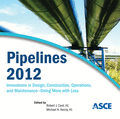PCCP Condition Assessment Methodology: What Is Right for You?
Publication: Pipelines 2012: Innovations in Design, Construction, Operations, and Maintenance, Doing More with Less
Abstract
Established as a Union Pacific railroad tent town in 1867, Cheyenne, named for a local Indian tribe, is now a progressive city that celebrates both its pioneer heritage and tomorrow's technology. As a railroad and cattle center, Wyoming's capital and largest city has always been an important Western crossroads and a unique blend of Western Cowboy, Military, and Contemporary cultures. As a city grows, the need for infrastructure to support the basics of life, e.g. water, for a community efficiently and effectively becomes necessary. In the early 1960's, Cheyenne began to realize that their growing water demands for water could not be sustained with existing water wells and surface water, so Cheyenne once again applied its pioneering heritage and great forethought to develop an additional source of water. Because water rights in the North Platte River drainage were already appropriated during normal flows, Cheyenne looked farther west, over 115 miles to the headwaters of the Little Snake River in the Sierra Madre Mountains on the western slope of the Continental Divide. As a result, an intricate trans-basin diversion plan was developed whereby water collected from the Little Snake River drainage could be traded for water from a closer and more deliverable source. The water collection system known as the Little Snake River Water Project - Stage I and Stage II was completed in 1965 and 1985 respectively. During the Stage II construction which included the installation of 21 miles of diversion piping consisting of reinforced concrete pipe (RCP) and prestressed concrete cylinder pipe (PCCP), the project was plagued with unique challenges that resulted in circumferential cracking of the PCCP pipe caused by poor pipe support/compaction and faulty design assumptions. To address these issues, a series of repairs were developed and instituted. These repairs were not directed at pressure related failures as there was no evidence of a loss of core compression/prestress, the fundamental property concerning the integrity of PCCP pipe. With appropriate background information and knowledge of the piping system, a systematic plan for sequencing the necessary field work and engineering analysis to maximize the return on the invested inspection dollars through the prudent use of technology, whether it be geotechnical, visual, aural, or electromagnetic inspection methods.
Get full access to this article
View all available purchase options and get full access to this chapter.
Information & Authors
Information
Published In
Copyright
© 2012 American Society of Civil Engineers.
History
Published online: Nov 9, 2012
ASCE Technical Topics:
- Concrete
- Concrete cylinder pipes
- Concrete pipes
- Drainage
- Engineering materials (by type)
- Hydraulic engineering
- Hydraulic structures
- Infrastructure
- Irrigation engineering
- Materials engineering
- Pipeline systems
- Pipes
- Rail transportation
- Reinforced concrete
- River engineering
- Rivers and streams
- Spillways
- Surface water
- Transportation engineering
- Water (by type)
- Water and water resources
- Water management
Authors
Metrics & Citations
Metrics
Citations
Download citation
If you have the appropriate software installed, you can download article citation data to the citation manager of your choice. Simply select your manager software from the list below and click Download.
